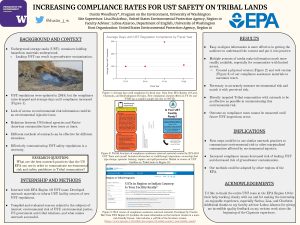Increasing Compliance Rates for UST Safety on Tribal Lands
In 2018, regulations for underground storage tanks (UST) containing hazardous materials, often petroleum, were updated to further improve the level of safety that they would provide. Following this change, compliance rates on Indian lands in the Environmental Protection Agency’s (EPA) Region 10 had dropped. If UST are not properly maintained, the risk of leakage increases, and this has the potential to contaminate groundwater and endanger communities that rely on it. The purpose of this study was to find the most effective ways in which the federal government can communicate environmental risk to tribal communities. During my internship with the EPA, my team and I developed compliance assistance outreach materials with the goal of increasing compliance rates to ensure that UST were being safely maintained. We developed a trifold brochure that we mailed out to UST facility owners on Tribal lands in Region 10 and to tribal environmental departments. Additionally, we developed a web version with the same information for easier reference and distribution. The main results of my work included finding that having multiple avenues of media when conducting outreach is essential for ensuring the information reaches the target audience, and that clarity of language while keeping complex information accurate is necessary. This has the potential to increase compliance rates for maintaining USTs, thus preventing leaks and improving the safety of their communities. Additionally, these strategies may be useful for other EPA regions in improving UST safety compliance in other communities.
